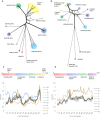Identification of a novel botulinum neurotoxin gene cluster in Enterococcus
- PMID: 29323697
- PMCID: PMC5838542
- DOI: 10.1002/1873-3468.12969
Identification of a novel botulinum neurotoxin gene cluster in Enterococcus
Abstract
The deadly neurotoxins of Clostridium botulinum (BoNTs) comprise eight serotypes (A-G; X). The neurotoxin gene cluster encoding BoNT and its accessory proteins includes an operon containing an ntnh gene upstream of the boNT gene. Another operon contains either ha (haemagglutinin) or orfX genes (of unknown function). Here we describe a novel boNT gene cluster from Enterococcus sp. 3G1_DIV0629, with a typical ntnh gene and an uncommon orfX arrangement. The neurotoxin (designated putative eBoNT/J) contains a metallopeptidase zinc-binding site, a translocation domain and a target cell attachment domain. Structural properties of the latter suggest a novel targeting mechanism with consequent implications for application by the pharmaceutical industry. This is the first complete boNT gene cluster identified in a non-clostridial genome.
Keywords: Clostridium; Enterococcus; botulinum neurotoxin; eBoNT/J.
© 2018 The Authors. FEBS Letters published by John Wiley & Sons Ltd on behalf of Federation of European Biochemical Societies.
Figures




References
Publication types
MeSH terms
Substances
Associated data
- Actions
- Actions
Grants and funding
LinkOut - more resources
Full Text Sources
Other Literature Sources

